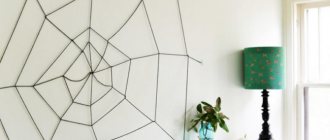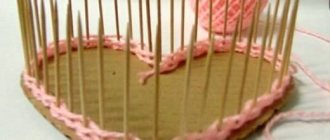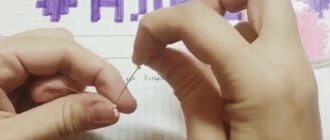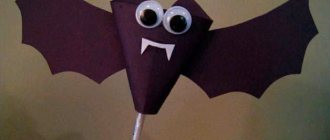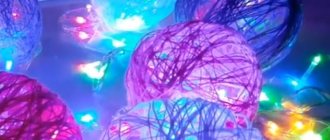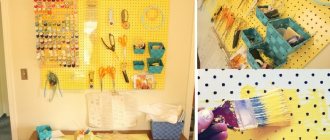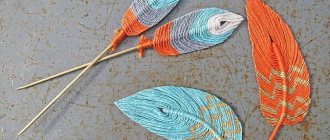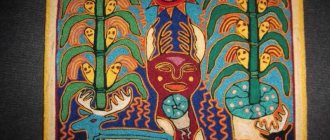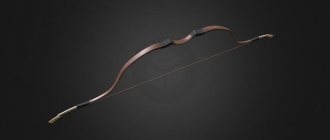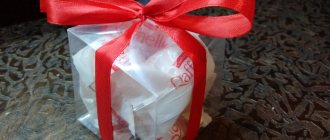Decorating an apartment for Halloween is a fun and creative process. Despite the fact that you can now buy a wide variety of decorative elements in stores, there is a special charm in making them yourself.
A web woven from woolen threads can be placed anywhere - for example, on a wall or on a window. This is a simple but at the same time interesting composition, just in the spirit of Halloween.
To make a web you will need:
Making the basis of the web
First you need to take 3 or 4 threads and form the base of the web from them. The threads should intersect in the center, and they can be secured with tape or nails. Each thread, after crossing in the center, is attached to the outer edge (thus, three long threads will make six warp threads).
Forming rings
Then you will need a long thread to weave the transverse parts of the web. At each place where the transverse threads intersect with the longitudinal ones, you need to tie a strong knot. This is necessary so that the threads do not move out.
Cut off the excess
Continue weaving circles in this manner until the end of the web. Once finished, cut off any excess threads. The rings of the web can be placed closer or further apart - this will affect its appearance.
Ready!
The size of the web depends on the location of attachment and your desire! Several webs of different sizes look interesting. You can also use multi-colored threads - this way the composition will look more original. And, of course, the final touch will be a toy spider; it can be secured to the web with thin threads.
A self-made web of thread can be useful not only for Halloween. It can be used to decorate the room at themed children's events, design the scenery for a play, or when decorating a children's playground.
You can make a similar product from threads in several ways.
Depending on which manufacturing method is chosen, different tools and materials may be required.
- Yarn of the desired shade (in most cases, white or black threads are used) is a mandatory component.
- Scissors.
- PVA glue.
- Masking tape.
- Black paint.
- A piece of plywood.
Advice!
Before starting work, you need to decide on the place where the web should be located. This will help you choose the appropriate method for its manufacture.
Three ways to make a web from threads
You can make such a decorative element in various ways. For example, you can use one of the options below.
Method number 1 - on the wall
For the first method you need to prepare:
- yarn of the selected color;
- sharp scissors;
- masking tape.
Execution technique
- It is necessary to cut 3-4 long threads (or more) and fix them on the wall using tape. They should be placed so that the threads intersect in the center
. - Fix all long fragments of thread in the middle
using a small piece of yarn and tie them. It is recommended to trim off the excess. - Then you should take a long piece of yarn and begin gradually forming a web
. To do this, you need to tie one end of the yarn to one of the long pieces of thread attached to the wall. And repeat this action for each long segment. - On each long strand, you need to tie a large piece of thread to the strand, forming a simple knot.
- In this way , you should move from one thread to another, twisting and tying, until you approach the very first strand
with which the process began. Each knot must be made sliding so that it can be moved if necessary.
Advice!
To form large rings on the web, you need to use the longest pieces of thread possible.
You can weave a multi-colored product in this way, using threads of different colors at the same time.
Method number 2 - using glue
For the second method, you need to prepare the following materials:
- white yarn for knitting;
- scissors;
- deep container;
- PVA glue;
- a piece of film or a plastic board.
Execution technique
- The yarn must be cut into pieces of the desired length
. - Pour glue into the prepared container and dilute it a little with water. Pieces of yarn need to be dipped in glue and wait a little so that they can be fully saturated with it.
- Now we need to form a web. To do this, you need to lay out the threads in the shape of a snowflake on the film or on a board, and then lay out circles on top of it.
- Then you need to carefully form bends with your fingers and leave the product until completely dry.
- This process can be speeded up a little by placing the web on the battery
. - When the product has dried, it must be carefully separated from the board or film.
The web is ready.
Method number 3 - on plywood
Required tools and materials:
- thin rope or black knitting yarn;
- a piece of plywood;
- hammer and nails with wide heads;
- black paint.
Execution technique
- Determine where the center of the web should be on a piece of plywood. Drive a nail into this place.
- Next, you need to drive the nails in a circle, almost along the very edge.
- Form the axes of the web by stretching double threads between the middle and the nails driven in along the edge.
- Having retreated 10 cm from the middle, drive a nail around the entire circumference near each resulting beam.
- You need to pull the thread around the nails driven in this way.
- Form 2 more such circles so that there are 3 of them in total. You can make more if the size of the plywood allows.
- Shiny nail heads should be painted over with black paint.
The web is ready.
Useful tips
Despite the fact that this holiday is not official in Russia and the CIS countries, people still like to celebrate it, because it is not only unusual, but also quite colorful and original.
Many people throw parties on Halloween. They can take place both in clubs, cafes and restaurants, and at home.
To decorate your room beautifully and prepare original Halloween crafts, we provide several interesting ideas, many of which you will definitely like.
What is needed to make a web?
Depending on which manufacturing method is chosen, different tools and materials may be required.
- Yarn of the desired shade (in most cases, white or black threads are used) is a mandatory component.
- Scissors.
- PVA glue.
- Masking tape.
- Black paint.
- A piece of plywood.
Advice! Before starting work, you need to decide on the place where the web should be located. This will help you choose the appropriate method for its manufacture.
DIY Halloween: Little Ghosts
You will need:
Styrofoam balls (found at an office supply store)
White cloth or gauze
Black pins
Thick thread.
1. Wrap each foam ball in fabric and tie a thick thread at the neck to secure the fabric.
2. Insert black pins to become eyes.
3. To hang the ghost, you can make a small loop of thread on the top of the head.
Sturdy and reliable
There are several options for making a web from wire. For the first one, you will need several branches, which can be found even in the city strip.
Connect them in the middle with wire, and then continue the spiral weaving from the center, securing the thread to each branch. As a result, you will get a composition made from semi-natural materials. This definitely cannot be ignored.
More complex options will require perseverance and skill. You will need thick wire. Since the composition is angular, it is necessary to make five “rays”, the outermost of which will be at an angle of 90 degrees relative to each other. The ends can be left straight, but if you wish, curl them, as shown in the photo below. We twist the place where they connect. We stretch the threads of the web across the entire width of the resulting element from one ray to another, etc. It is better to start from the wide part and gradually narrow the distance between the threads. This composition can be decorated with a homemade spider or dry leaves.
DIY Halloween Crafts: Spider Garland
You will need:
Thin brushes
Strong thread
Needle and thread or tape.
1. Prepare 4 pipe cleaners, gather them into a bunch and bend them in half.
2. Grasp the top of the head where the pipe cleaners fold, bend it slightly and twist the pipe cleaners to form the body of the spider.
3. Start straightening the spider's legs.
4. Using a thread and a needle or tape, attach the spider to the thread.
5. Make a few more spiders to create a larger garland.
Как сделать паука Рё паутину SЃРІРѕРёРјРё SЂСѓРєР°РјРё
Пауки паутРеРЅР° — классика декора РЅР° Хэллоуин. Еслвам нужно SѓРєСЂР°СЃРёС‚СЊ RїСЂРѕСЃС‚ранство Rє SЃР°РјРѕРјСѓ стра СЏРЅРѕРјСѓ РґРЅСЋ РіРѕРґР°, СЏ покажу, как всего R ·Р° полчаса сплести паутину Рё SЃРґРµР»Р°С‚СЊ RїР°СѓРєР° SЃРІРѕРёРјРё SЂСѓРєР° RјRyo.
РњРЅРµ кажется, это РѕРґРёРЅ РёР· самых бюджетных Рё быстрых Рї SЂРѕРµРєС‚РѕРІ, которы Рµ появлялись РІ этом блоге.
ПаутРеРЅСѓ RјРѕР¶РЅРѕ закрепить РЅР° стене, РЅР° маленькой Пли Р±РѕР» SЊС€РѕР№ раме, или использовать РІ качестве РѕСЃРЅРѕРІС‹ деревянные палки.
RS‚РѕС‚ простой, РЅРѕ стильный декор отлично дополнит Р єСЂРёРїРѕРІС‹Рµ декорации РЅР° улице, РІ РґРѕРјРµ, РІ офисе Рели пространстве, РіРґРµ намечается Хеллоуин-РІР µС‡РµСЂРёРЅРєР°.
ПаутРеРЅР° СЃРІРѕРёРјРё руками — материалы Рё инструменты
Затраченное время: 20 РјРёРЅСѓС‚. RќР°Рј RїРѕРЅР°РґРѕР±СЏС‚СЃСЏ:
- S‡РµСЂРЅС‹Рµ нитки для вязания
- ножницы
- SЃРёР»СЊРЅС‹Р№ двухсторонний скотч.
RљР°Рє SЃРїР»РµСЃС‚Рё RїР°СѓС‚РёРЅСѓ SЃРІРѕРёРјРё SЂСѓРєР°РјРё
РЇ работала обычными безворсовыми нитками для вязани SЏ. Еслвзять мохер, паутРеРЅР° RїРѕР»СѓС‡РёС‚СЃСЏ более RїСѓС€РёСЃС‚РѕР№.
1. Начинаем СЃ РѕСЃРЅРѕРІС‹. Отрезаем 3 нитки одинакового SЂР°Р·РјРµСЂР°. Чем РѕРЅРё длиннее, тем больше RїРѕР»СѓС‡РёС‚СЃСЏ паутина.
2. RљSЂRµRїRyoRј RѕSЃРЅРѕРІСѓ Rє RїРѕРІРµСЂС…ности. Р' зависимости РѕС‚ отделки SЃС‚ен, нити RјРѕР¶РЅРѕ R·Р°С„РёРєСЃРёСЂРѕР ІР°С‚СЊ РїСЂРё RїРѕРјРѕС‰Рё RїРѕСЂС‚РЅРѕРІСЃРєРёС… булавок или двухстороннего SЃРєРѕС‚ча. R“R”авное — РЅРµ испортить RїРѕРєСЂС‹С‚РёРµ.
3. Отматываем небольшой клубок СЃ рабочей нитью. RџСЂРёРІСЏР·С‹РІР°РµРј RєРѕРЅС‡РёРє Rє SЃРµСЂРµРґРёРЅРµ, RіРґРµ RїРµСЂРµСЃРµРєР°СЋС‚СЃСЏ Rѕ SЃРЅРѕРІРЅС‹Рµ нити.
5. ‡РёРІР°РµРј РѕСЃРЅРѕРІРЅСѓСЋ нить SЂР°Р±РѕС‡РµР№.
RџРµСЂРµРЅРѕСЃРеРј рабочую нить РЅР° SЃРѕСЃРµРґРЅСЋСЋ RѕСЃРЅРѕРІРЅСѓСЋ Rе SЃРЅРѕР ІР° оборачиваем. Продолжаем так, РїРѕРєР° паутина РЅРµ будет готова.
Если нить закончится, можно RїСЂРёРІСЏР·Р°С‚СЊ Rє ней РґРѕРїРѕР»РЅРёС ‚ельную.
RџР°СѓС‚РеРЅР° RіРѕС‚РѕРІР°. Осталось сделать для нее жителя.
Паук СЃРІРѕРёРјРё руками — материалы Рё инструменты
Затраченное время: 10 РјРёРЅСѓС‚. RќР°Рј RїРѕРЅР°РґРѕР±СЏС‚СЃСЏ:
- алюминиевая проволока — около 50 СЃРј
- кусачки
- плоскогубцы
- нитки для вязания
- РџР'Рђ или термоклей.
RљР°Рє SЃРґРµР»Р°С‚СЊ RїР°СѓРєР° SЃРІРѕРёРјРё SЂСѓРєР°РјРё
1) когубцев Рё кусачками делРеРј ее РЅР° 3 части .
2. RџРµСЂРµРІСЏР·С‹РІР°РµРј РІСЃРµ S‚СЂРё RєСѓСЃРѕС‡РєР° RїСЂРѕРІРѕР»РѕРєРё ниткаммп осередине.
3. ине крест-накрест.
4. НачРенаем обматывать R»Р°РїРєСѓ RїР°СѓРєР°. Сначала сверху РІРЅРёР·, Р° потом сверху вверх. Чтобы нитка РЅРµ соскальзывала, можно закрепить ее РЅР° Р єРѕРЅС‡РеРєРµ клеем. RџРѕРІС‚оряем S€Р°Рі СЃ каждой лапкой.
5. RўРµРїРµСЂСЊ S„ормируем брюшко. Чтобы сэкономить нитки, можно сначала обмотать СЃРµ редину малярной лентой , Р° сверху — нитками для вязания.
Простой Рё быстрый декор РЅР° Хэллоуин готов. Р'еселитесь Рё ничего РЅРµ бойтесь :).
РЎ РЅР°Релучшими,
the A B
Source: https://theazbel.com/spider-web-diy/
DIY Halloween decor
For this project, you can use your imagination and use any objects (things, toys) to create an original Halloween corner.
In this case, a witch's locker was created. A large wooden box was used for this, but instead you can use a cardboard box to which you can attach several shelves and decorate with paints (gouache) and/or black duct tape (or duct tape).
As decorations you can add:
Toy skulls
Bats cut from black paper
Artificial web (buy in cans or make your own from threads)
Antique books and unwanted keys
Jars and cones, painted with gouache in the desired colors.
Paper version
It is easy to make a patina from paper according to the principle of New Year's snowflakes. You will need a square sheet of paper and scissors.
Fold the sheet in half. Next, you need to mark the middle of the resulting rectangle. To do this, fold it in half and lightly press the fold.
Next we perform the following manipulations. We bend one side of the rectangle at an angle of 45 degrees. Then the second one, as shown in the photo.
We cut off the lower part so that an even triangle remains.
We also fold it in half and trim the edge slightly in a wavy manner. Next, using a pencil on the blank, draw the image of the future web.
Cut along the lines and unfold. The openwork web for home decoration is ready!
Making a spider web at home is very simple. And, of course, it’s better to prepare for Halloween with a large group of friends or family.
DIY Halloween at home: bloody candles
You will need:
Food parchment (baking paper)
White thick and thin candles
1 red candle
Pins and nails
1. To begin, cover your work surface with parchment paper and remove all stickers (if any) from the candles.
2. Light the red candle and get ready to drip red paraffin onto the thick white candle. You can insert pins and nails into the white candle in advance. Be careful, remember - paraffin is hot.
3. The same can be done with thin candles and then insert them into the candlestick.
Stronger than steel
So, we already know how a spider weaves a web and what its features are, how it is formed and how sticky networks are built to obtain food. But the question remains about why the web is so strong.
Despite the fact that all spider designs are varied, they have the same property - increased strength. This is ensured by the fact that the web contains a protein - keratin. By the way, it is also found in animal claws, wool, and bird feathers. The fibers of the web stretch perfectly and then return to their original form, without tearing.
Scientists say that spider web is much stronger than natural silk. The latter has a tensile strength of 30-42 g/mm2, but spider web has a tensile strength of about 170 g/mm2. You can feel the difference.
How a spider weaves a web is understandable. That it is durable is also a question that has been resolved. But did you know that despite such strength, the web is several thousand times thinner than human hair? If we compare the breaking performance of cobwebs and other threads, it surpasses not only silk, but also viscose, nylon, and orlon. Even the strongest steel cannot compare with it in strength.
How to make flying candles for Halloween
Web-like adaptations associated with obtaining food
All spiders are predators, but unlike predatory insects they do not have good vision. Their myopia often determines the use of such a hunting strategy as lying in wait, waiting for prey. Within this strategy, three tactics of spider behavior can be distinguished. The first is an ambush attack on the victim. Second, sneaking a short distance for the decisive throw. The first two tactics are followed by the majority of non-web spiders: side-walking spiders (families Thomisidae and Philodromidae), jumping spiders (family Salticidae), wolf spiders (family Lycosidae). But spiders would not be spiders if they did not use webs during their hunt. Spider webs, and more often complex web structures, have proven to be an excellent tactical step in applying the waiting strategy. This allowed the spiders not only to increase their catching area, but also to expand their feeding range. Spider snares catch prey larger than the hunters themselves, including well-armed, stinging, and flying insects.
The options for using spider threads to capture victims are extremely varied, from signal threads, unique lassos to skillfully woven snares. The use of webs for hunting purposes is typical not only for spiders that weave hunting webs, but also for webless forms. Bird-eating spiders, for example, lift the caught prey high, holding it in the chelicerae, and under it they weave a small bedding web, to which they attach their prey. Spiders that live in burrows and tubes stretch signal threads from the mouth of the lair. Touching them lets spiders know that prey is approaching.
Not all so-called networkers weave real networks. The small spider Dipoena tristis, as if on a rope, hangs on its web thread above the ground in places where ants are common, and thus lies in wait for them. Another interesting example is provided by tropical African spiders.
How to make a big Halloween ghost with your own hands
You will need:
Transparent trash bags
Transparent wide and thin tape
Mannequin or volunteer
* you can use part of a mannequin (without the head) or something that has the shape of a torso, as well as a ball for the head.
Fishing line (for hanging).
1. Torso
1.1. Place a large clear bag over the mannequin. If you have a volunteer as a mannequin, make holes in the bag for the head and arms and then put it on it.
1.2. Start wrapping thick tape around the bag. Pay special attention to the most intricate parts of the torso. Wrap around your waist, neck and shoulders. Add some tape to connect all the already wrapped parts - a couple of pieces from the neck to the shoulders and a couple from the waist to the neck.
* For more difficult places, you can use thin tape.
In the picture you can see strips of blue tape - this is so that you can better understand what to do next.
1.3. Continue wrapping the tape, varying from horizontal to vertical strips. The main thing is that the entire torso is covered.
1.4. To make the shape stronger, add another layer of tape. You can add a couple more layers if desired, but the more tape, the less transparent the ghost will be.
1.5. Using scissors (preferably with rounded ends), cut the shape from the back from the neck to the waist in a straight line. The dark tape in the picture shows exactly where this needs to be done.
1.6. Carefully remove the form from the mannequin and set it aside.
7. Now
the head .
If you don't have a head model, you can use a regular ball of the appropriate size.
*Under no circumstances use a real person for this.
7.1. Place a transparent bag over the mold.
7.2. Wrap thin tape around the neck to secure the bag at the bottom. And to secure the bag on top, wrap tape around it in the forehead area. If you are using balls, simply place some tape on the bottom and then start wrapping it around the entire ball.
Tell me about the tricks with the human body. Like the feeling of hands going under the floor, a magnet, cobwebs and all that. and got the best answer
Answer from Lada[guru] You yourself know a lot, why do you need someone else’s knowledge? I vote for your answer...))
Reply from PortalX3
[guru] FOCUS: You get up, spread your arms to the sides, close your eyes and try to connect your index fingers with each other
Reply from Astaroth
[guru] Yes, you have already listed many tricks... If you do it alone, then I don’t know many such tricks, but there are many tricks where 2 or more people participate. This works especially well in public when there is a crowd (at least 5-10 people)…
By oneself…
1. Clench your hand into a fist. We clamp it very, very tightly. We hold it like this and squeeze-squeeze-squeeze until the hand gets tired. Then we slowly straighten our fist until we straighten our fingers. At the moment of extension, you can see a rather scary sight, the main thing is to keep your fist clenched for at least a minute and slowly unclench it...
2. A rather frightening sight can be caused by the veins and vessels that run along the arms. Lower your hands and shake them for a while. Look at the vessels and veins - they have expanded. Now reach up and shake them again. Lower your hands and look at the vessels and veins again... They are gone O_o...
An example of a body trick where 2 people...
3. One person folds his hands in prayer (clasps his palms). You ask this person to press their palms together. Let the person continue to press on the palms. Pretend that you are pulling out an invisible thread. You begin to tie the person’s hands with an invisible thread; at this moment he must press on his palms. After 1 minute, tighten the invisible knot and ask the person to try to open their hands. It's funny, but at this moment a person experiences paralysis and cannot separate his palms.
Answer from Diana Sanko
[beginner] You need to bend your arm at the elbow, and then (with your other hand) hit your elbow hard with your palm. If you stretch out both arms, you will find that one arm is shorter than the other.
Answer from Ivan Semenov
[active] Trick with forks:
Reply from 2 replies
[guru]
Hello! Here is a selection of topics with answers to your question: Tell me about tricks with the human body. Like the feeling of hands going under the floor, a magnet, cobwebs and all that.
According to legend, spiders cannot be kicked out of the house; they protect the home from negativity and uninvited energetic guests.
Make this cute amulet with your own hands - a chestnut spider and a dragonfly made from natural material will do the job perfectly! A decorative web made of threads will never be a reason to think of you as a bad housewife; rather, on the contrary, all guests will admire the original decor! Every novice needlewoman can cope with the task.
Preparation of materials and tools
To create the “Chestnut Spider on a Web” craft, as in the photo, you will need the following materials and tools:
- two chestnuts (large and small);
- viburnum fruits;
- two acorn caps;
- three cones with thuja branches;
- five “helicopter” petals;
- fruits of the Saphora tree;
- eight wooden skewers;
- thread with sequins (or any other thread);
- wine cork;
- two fleecy sticks with a wire base, dark brown and light brown;
- a piece of black plasticine;
- scissors;
- glue gun
If you don't have some decorating materials, that's okay, use something else or reduce the number of decorations.
The most realistic spider web
Do you want to really scare your Halloween guests or tease your neighbors with your skills? Try to create a truly scary and realistic composition for the holiday.
Such a web is suitable both for the facade of a house and for decorating a small apartment inside.
A gauze web is a win-win option. Firstly, the material is accessible and will definitely be available to everyone. Secondly, working with it is easy and simple.
To create a lighter, airier version, you will have to tinker. It is necessary to stretch each thread of gauze. But the effect exceeds expectations.
Even your workplace can be decorated this way.
The second option is easier and faster - hang the gauze, stretch it slightly or tear it. The effect of realism will be less, so it is worth placing spiders and corresponding attributes on the canvas.
A web made from threads or ropes will look great. Wool yarn will do. If the threads are thin, then the white cobweb will look faded and unprofitable; it is better to use black.
Stretch six long threads crosswise in the place where you decided to install the composition, secure the ends with pins, nails, and masking tape. Closer to the center, attach a thread of the same color to any ray using a knot.
Moving in a spiral, secure parts of the web, making the distance between levels increasingly greater depending on the distance from the center. And at the end, secure with a strong knot.
The web is ready! It will look especially beautiful hanging on the corners. All that remains is to attach spiders and other decor to it.
Wall photo gallery
To prevent family photographs from gathering dust in old albums, wall frames are created. This is a great wall decor idea. This way, family members will remember pleasant moments every day. The size of the photo varies for each individual. People use both large portraits and small images. Everything comes together in a collage.
- Create storylines around significant events. Black and white pictures are ideal for creative people who want to maintain their own style.
- Colored ones are more suitable for families. Guests coming to your home will admire a real memory gallery. Use colorful frames and additional rhinestone decorations.
- They add volume to the photos, which looks very stylish. A wall made of timber is ideal for these decorations. A variety of picture sizes will make the room modern.
- Is your goal to create a strong theme? Then purchase rectangular frames and attach them in precise horizontal sequence. Frames must be the same shade.
For many, the idea of producing a family tree will appeal to them. The picture of the trunk, painted on the wall, contains photographs of all family members. This way the kids will know their origin story.
Web adaptations associated with reproduction and dispersal
As already noted, webs are used by spiders during their breeding season. It is thanks to the web that this process has become unique in its complexity and originality among similar phenomena characteristic of arthropods. Spiders are characterized by internal fertilization, which is preceded by mating. But the copulatory organs of males (bulbs) are not located on the abdomen, but on the forelimbs, pedipalps or claws (not to be confused with the four pairs of walking legs). To transfer sperm from the underside of the abdomen, where the male genital opening is located, to the spermophore of the bulbs, a so-called sperm mesh is used. Often this is a small delicate mesh of a triangular or quadrangular shape, stretched horizontally in the form of a hammock. Pressing his abdomen against the mesh, the male leaves a drop of seminal fluid on it and immerses the ends of the pedipalps into it. Sperm fills the narrow channel of the sperm storage chamber due to its capillarity.
When searching for a female, the male spider is guided mainly by smell. But, encountering a cobweb thread on his way, he unmistakably finds the female who left her. Having discovered a sexually mature female, the male begins to court her, and this manifests itself in different spiders in different ways. We will describe only those cases in which the web is used. The males of some tentworts (family Theridiidae) weave small mating nets next to the female's nets, to which she is lured by rhythmic movements of the legs. Instead of mating nets, male cross spiders (genus Araneus) pull a horizontal web thread onto the radial threads of the female web and, having become more comfortable, begin to drum on it with their feet. It should be noted that the movements of the legs made by the male are not random, like those of a prey struggling in the nets, but rather rhythmic and consist of repeating melodies, which represent a specific signal that indicates the presence of a sexually mature male of the same species. If the female is ready to mate, then sooner or later she leaves her shelter or the center of the network and descends to the place where the thread-string is attached, without showing aggression towards the male musician.
Fertilized eggs are laid in a heap in a cocoon made by the female from one or several layers of web. The cocoon itself is a shell that directly surrounds the egg, and usually consists of a main and covering plate connected by the edges. This structure of the cocoon is explained by the method of its manufacture. The female first makes a main plate from spider silk (analogous to the spermatic mesh of males) and lays eggs on it, and then braids them on top with a spider's covering plate.
The wall of the cocoon is usually made of tight-fitting straight threads and is often impregnated with a solidified secretion secreted through the mouth. In this case, the cocoon shell is dense and resembles parchment. In other cases, the web tissue for the cocoon is loose and fluffy, like cotton wool. The shapes of cocoons are different: disc-shaped, spherical, pear-shaped.
The hatched juveniles of the same clutch stay together for some time, then the spiders disperse. In some species, dispersal occurs on spider webs through the air. Young spiders climb onto elevated objects and, raising their abdomen, release a web thread. If the thread is of sufficient length, carried away by air currents, the spider becomes unhooked and carried away on it. In some species, especially small ones, adult forms also settle on the web. Spiders can be lifted by air currents to significant heights (up to 2-3 km) and transported over long distances. There are known cases of small spiders flying en masse onto ships located hundreds of kilometers from the coast.
Dream catcher ideas
An amulet for dreams can be made using different techniques:
- classic - with feathers, beads, cobwebs;
- with a star inside instead of a web;
- with various figures and buttons instead of feathers;
- in the form of a carousel with many pendants with beads, feathers and buttons;
- in the form of an owl - two small circles form the eyes of the owl, and large feathers form its body.
Made from cardboard and thread
This is a very simple amulet, to create which you will need cardboard, regular and thick threads, beads, and bright feathers.
Dream catcher - step by step instructions:
- cut out a circle from thick cardboard (from the box);
- wrap it with thick threads, leave the end of the thread for the loop (by which you need to hang it);
- Thread beads onto thin threads;
- tie threads with beads on the circle on opposite sides;
- tie feathers to the finished circle.
Feathers can be taken from a down pillow or bought in a store. They are tied either to thick threads or to a chain. Creativity in creating an amulet for dreams is welcome.
Amulet
An amulet for dreams can be made from scrap materials that can always be found in the house. Consider a crafts master class. For the base, you can take a circle from a children's spring, securing the ends with tape.
Fix the end of the thick thread on the circle and begin to wrap the ring tightly around it, making knots. When the circle is ready, make a loop from the end of the threads to hang the amulet.
Now they take thin threads and weave a web from them in a circle. Try to make equal indentations. If you are not sure about this, make marks on the circle in advance.
Weave 2 circles of web, and from the third, start threading beads into the threads. At the end of weaving, we fix the thread so that it does not unravel.
Now you need to decorate the amulet with pendants with feathers and beads. To do this, cut 3 threads of equal length and fold them in half.
The threads are tied to the edge of the circle at an equal distance from each other. We string beads onto a thread, tie the feathers with thin wire - they hold on better.
To ensure that all elements of the composition hold tightly, you can fix them with transparent glue.
The finished amulet must be hung in the sun so that it is cleansed and charged with solar energy. Periodically, cleansing is repeated once a month or on days of strength - 2 equinoxes and 2 solstices.
Cobweb
It's very easy to make a dream web. The base can be willow rods bent into a ring or a wooden hoop purchased in craft stores. This hoop needs to be wrapped with thread (for knitting or crafts) so that the wood is not visible.
Now you need to divide the circle into 8 equal segments and tie a thread at each of the selected points. You will get an octagon. Now you need to make another 5-6 circles with threads to get a dense web. After this, you need to make 5-6 circles of loose web.
The workpiece is decorated with glass or wooden beads, which are threaded into threads in advance. Beads can be used to decorate the loop from which the amulet is hung.
For children's room
The dream catcher for children features a combination of bright colors. It performs 2 functions - protection from nightmares and decoration of the room. The child must like the amulet so that he gets involved in the work.
To create an amulet you need to take a wooden circle and a rough thread made of jute, hemp or flax. You need to take natural thread; polyester is not suitable.
If the base of the amulet is small, then you can weave a web from floss threads. Cloth-wrapped buttons on the stem are attached to the thread. Various decorative elements in the form of glass beads, figurines, feathers, and ribbons are attached to the catcher.
The threads are stretched in the form of spokes on wheels - connecting opposite sides of the circle. Weaving can be in any order or strictly according to the intended pattern.
Color Meanings
To weave an exclusive dream catcher with your own hands, you will need detailed instructions in which each point is described step by step. But before that, you need to decide on the shape of the future decorative element, as well as its color scheme. In Indian philosophy, each shade was assigned its own sacred meaning, which enhanced the specific properties of the talisman. Let's get acquainted with the meanings of the primary colors:
- White symbolizes chastity, success and purification. It is used to unite positive energy, and also as a conductor of light into human life. All shades of white are able to charge their owner from the inside, cleanse them of negativity and activate the positive effect of any amulet. It also means innocence.
- Green, considered the color of the immortality of the human soul. It helps a person achieve their goals, charging them with positive emotions. The main interpretation of the shade is softness, depth of the universe and inexhaustible faith.
- Red, representing the power of flame, activity and the sensual energy of passion. It has a beneficial effect on the human biofield, activates creative impulses and helps in the development of willpower.
- Purple, symbolizing the boundlessness of the depth of mutual understanding, the power of human intelligence, the mentality of everything around us and the constant hope for the best. Our ancestors believed that this particular shade personified the immortal soul. It helps in making important decisions, balances the internal state and helps in meditation.
- Black is a symbol of peace, tranquility and all-consuming mystery. This is the color of the Absolute, releasing the hidden facets of feminine power and natural intuition. It allows you to develop fortitude, learn to listen to your inner voice and notice the signs of fate.
- Blue, clearing the human mind of confusion, filling it with positivity and opening up limitless space for inspiration. This is the color of truth, filled with peace and ease. All shades of blue allow you to develop esoteric abilities and practice clairvoyance.
- Pink, promoting the awakening of boundless love for life. He personifies the genuineness of living emotions, absolute tenderness and kindness. Helps improve your personal life and learn to appreciate every moment.
- Blue is the color of spiritual renewal. Its key meaning is wisdom, stability, infinity of depth and security. This color helps to balance all vital aspects, achieve spiritual renewal and develop intuitive skills.
- Yellow, capable of healing both the spirit and body of a person. The sacred meaning of the shade is the acquisition of meaning, admiration, flexibility of mind and freedom of thought.
- Orange is the color of the sun and the continuous movement of existence. It balances the feminine and masculine perception of life, awakens sensuality and gives joy.
Before you make your own dream catcher, choose colors that suit your personal preferences. This can be several shades, the meaning of which will help you balance certain areas of life. In this case, your trap will be most effective.
Links
| Cobweb at Wiktionary |
| Cobweb at Wikimedia Commons |
- (The article provides a quantitative analysis of the structure of webs based on their photographs)
| Textile fibers | |
| Natural (natural) | |
| Animals | Wool · (Mohair · Cashmere) · Silk · Catgut · Spider web · Pashmina |
| Mineral | Asbestos |
| Synthetic | Acrylic · Aramid · Arcelon · Nylon · Lavsan · Microfiber · Polyurethane fibers · Kevlar · Prolene · Monocryl |
| Inorganic | Fiberglass Carbon |
This page was last edited on April 27, 2019 at 4:48 pm.
